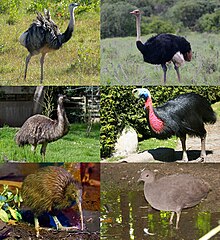| Paleognaths | |
|---|---|

| |
Palaeognathae biodiversity.
| |
| Scientific classification | |
| Domain: | Eukaryota |
| Kingdom: | Animalia |
| Phylum: | Chordata |
| Class: | Aves |
| Infraclass: | Palaeognathae Pycraft, 1900 |
| Orders | |
| |
Palaeognathae (/ˌpæliˈɒɡnəθi/; from Ancient Greek παλαιός (palaiós) 'old' and γνάθος (gnáthos) 'jaw') is an infraclass of birds, called paleognaths or palaeognaths, within the class Aves of the clade Archosauria. It is one of the two extant infraclasses of birds, the other being Neognathae, both of which form Neornithes. Palaeognathae contains five extant orders of flightless lineages (plus two that are extinct), termed ratites, and one flying lineage, the Neotropic tinamous.[1][2] There are 47 species of tinamous, five of kiwis (Apteryx), three of cassowaries (Casuarius), one of emus (Dromaius) (another became extinct in historic times), two of rheas (Rhea) and two of ostriches (Struthio).[3] Recent research has indicated that paleognaths are monophyletic but the traditional taxonomic split between flightless and flighted forms is incorrect; tinamous are within the ratite radiation, meaning flightlessness arose independently multiple times via parallel evolution.[4]
There are three extinct groups that are undisputed members of Palaeognathae: the Lithornithiformes, the Dinornithiformes (moas) and the Aepyornithiformes (elephant birds), the latter two of which became extinct in the last 1250 years. There are other extinct birds which have been allied with the Palaeognathae by at least one author, but their affinities are a matter of dispute.[citation needed]
The word Paleognath is derived from the ancient Greek for 'old jaws' in reference to the skeletal anatomy of the palate, which is described as more primitive and reptilian than that in other birds.[5] Paleognathous birds retain some basal morphological characters but are by no means living fossils as their genomes continued to evolve at the DNA level under selective pressure at rates comparable to the Neognathae branch of living birds, though there is some controversy about the precise relationship between them and the other birds. There are also several other scientific controversies about their evolution (see below).[6]
- ^ Wetmore, A. (1960). "A Classification for Birds of the World". Smithsonian Miscellaneous Collections. 139. Washington D.C.: Smithsonian Institution: 1–37.
- ^ Cite error: The named reference
Baker2014was invoked but never defined (see the help page). - ^ Clements, J. C. et al. (2010)
- ^ Cite error: The named reference
Mitchell2014was invoked but never defined (see the help page). - ^ Houde, P. T. (1988)
- ^ Leonard, L. et al. (2005)